News
Long Fibre Feed installation at CTS and connection to AESOP
2023-07-25
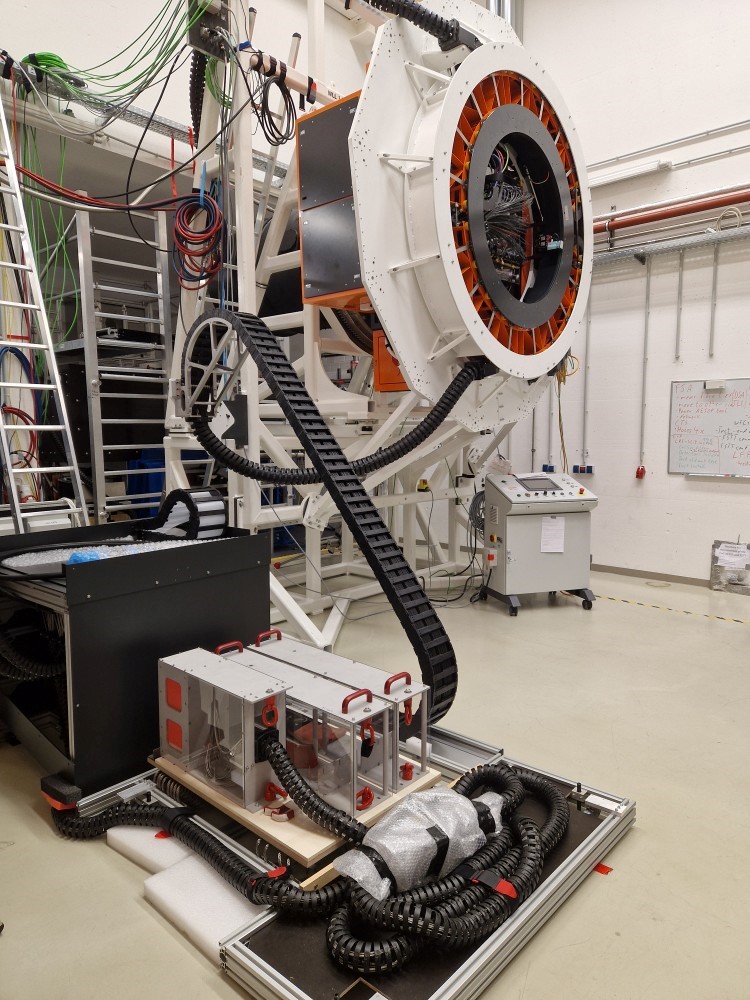
The 4MOST System Integration is proceeding nicely according to plan. On 19 July 2023, the final optical fibre relay with all the science and auxiliary fibres (aka, the Long Fiber Feed or LFF) was connected to the Fibre Positioner AESOP. This is an important milestone on the path towards full system integration in Potsdam. Please see the attached photos courtesy of Andreas Kelz (AIP).
"After the Fibre-Feed system has been built and assembled, it successfully passed Local Acceptance Review in May 2023," said LFF Workpackage Manager, Andreas Kelz. "Subsequently, the fibre system was folded, packed and transported across the AIP campus to the main integration hall, where it has been integrated into the Cassegrain Cable Wrap and mounted onto the Cassegrain Test Stand. The fibre elevation chain and strain relief units are mounted in the same positions as on VISTA. Finally, all 181 fibre connectors have been plugged to the backside of the AESOP positioner."
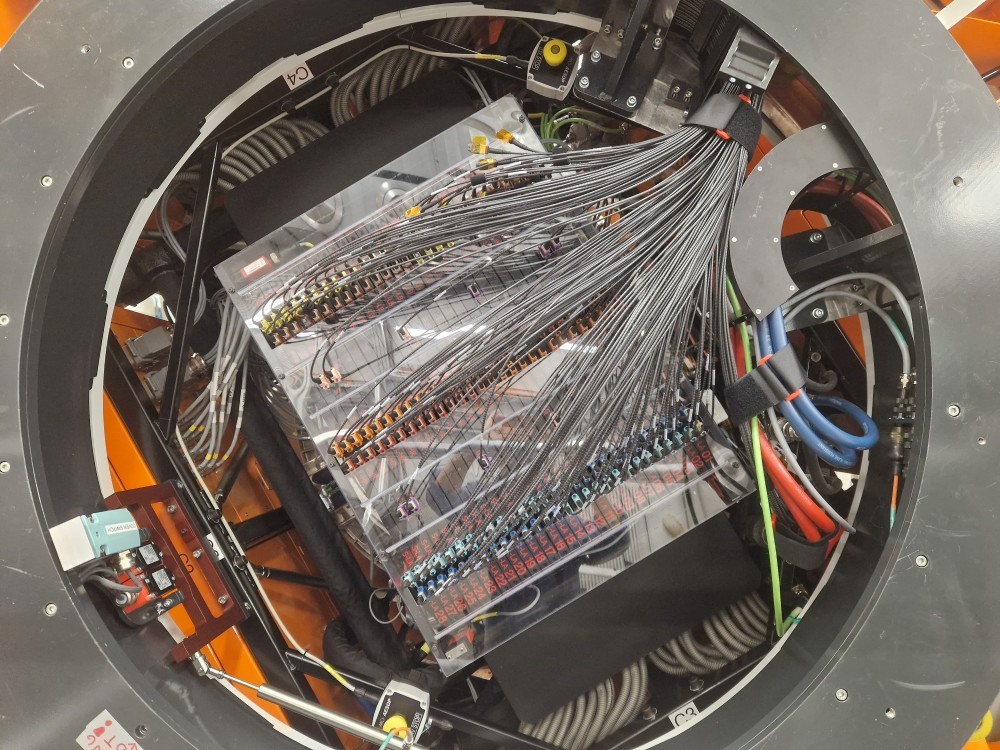
Unique view of the 4MOST focal plane
2023-07-20
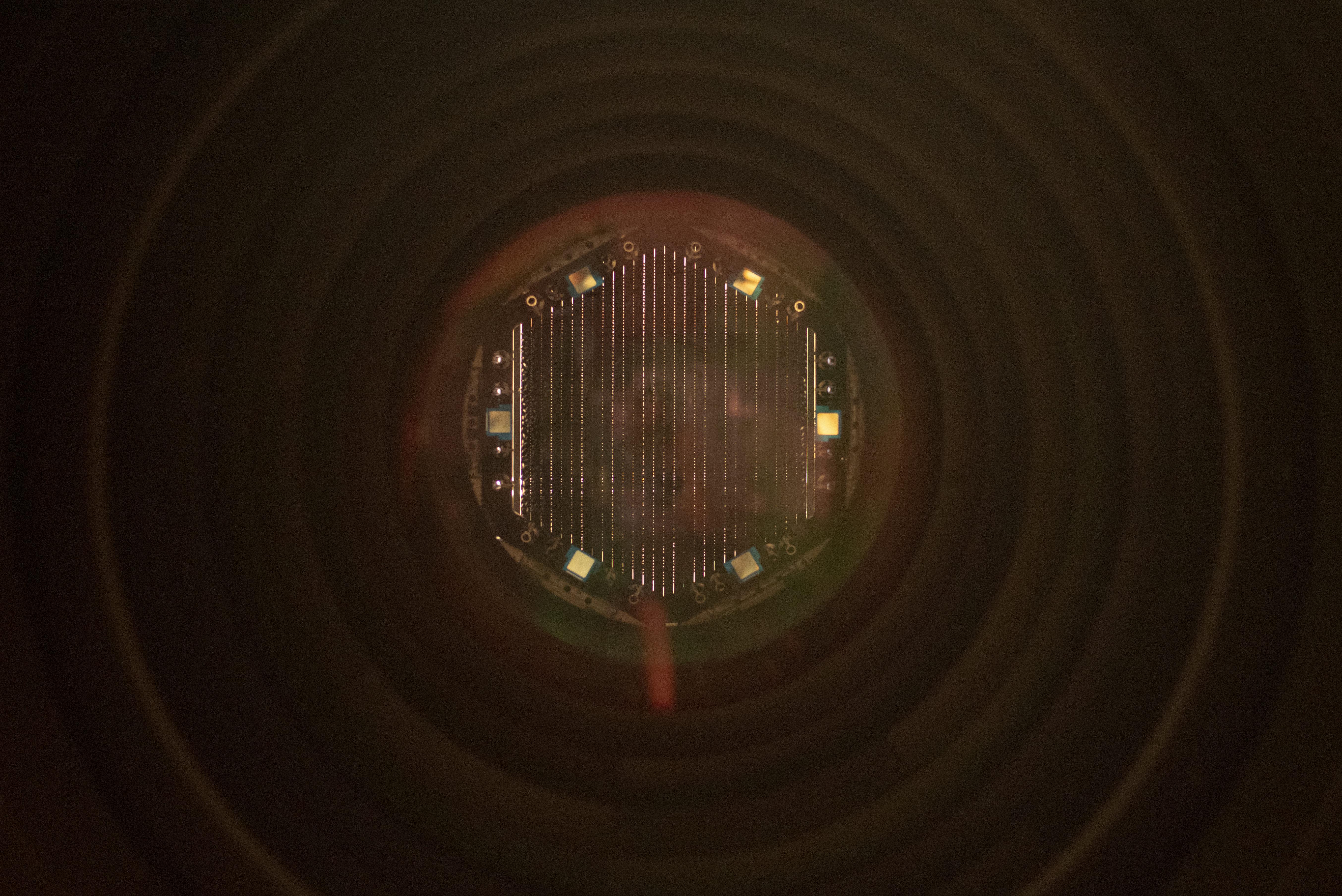
Courtesy of Michael Schroeck (AIP)
This photo was taken in the AIP Integration hall on 19 July 2023. It shows an amazing view of the 4MOST focal plane as seen through the Wide Field Corrector (WFC) from the perspective of the telescope’s secondary mirror. The hexagonal pattern of bright dots in the centre shows the area of the AESOP spines. Just outside the spines, visible as bright squares, one can recognise the six technical CCDs (guiders and wavefront sensors) through their pickup prisms. The bright rings are the fiducials used by the 4MOST metrology system to precisely measure the position of the spines. One can also spot the baffles inside the WFC as faint concentric rings outside the focal plane.
This is a rare occasion to enjoy such a view. It further demonstrates that 4MOST is complete and ready for verification in the AIP Integration hall!
Statement on TRR
2023-07-10
On July 3 and 4, the 4MOST Test Readiness Review (TRR) was held in Potsdam between ESO and the 4MOST Project Office. This review is an official major project milestone that manifests the transition from the system integration phase to the system verification phase. In broad strokes, the scope of the TRR is to verify that the hardware is available and working, and that documentation is complete before launching formal verification.
Not unexpectedly, the weeks leading up to the TRR were extremely busy. The effort that was put in by the 4MOST team was nothing short of amazing. Hardware was installed and tested, minor hardware issues were corrected, formal action items were addressed, documentation was updated and released. The sum of all these activities brought 4MOST a huge step forward towards completion.
On the second day of the TRR review, the ESO chair of the 4MOST PAE process summarized the findings and recommendations. Without going into too much detail, ESO was very impressed by the status of the HW in the integration hall. On subsystem level, the readiness was found to be adequate. There were however parts of the system level documentation that needs update and more detail to allow for an efficient execution of the verification activities. The PAE chair believed that the project will benefit from developing these documents further before proceeding with verification, and the decision was to postpone the TRR.
What is happening now is that some already scheduled verification activities will nevertheless proceed as planned. In parallel, the Project Office has made some internal priority changes with the goal of finishing the missing documentation as soon as possible. This includes a re-planning effort that will require some time to sort out before we can provide a new project schedule. We hope that we are able to finish this activity and present an updated project schedule in the next coming weeks. The PO believes that the overall delay triggered by the postponed TRR milestone will be quite moderate. Stay tuned!
Revised Code of Conduct
2023-07-07
At the recommendation of the Project Culture Working group, a few changes to the 4MOST Code of Conduct (CoC) were implemented by including the word "caste" in the example lists on discrimination and equity of opportunity and treatment. This new version has been endorsed by the 4MOST Executive Board, the Science Coordination Board and by ESO's Director for Science.
Every member of member of 4MOST is expected to know the 4MOST CoC and hence also this change, effective immediately. The new CoC is on DocuShare and on the web site.
Seeking second IWG6 lead
2023-07-07
The 4MOST Project seeks a second lead for IWG6 (Data Curation and Quality Control) with scientific background in Galactic astronomy to work together with the current lead on developing the 4MOST Quality Control pipeline (4QP) and coordinating the activities of Infrastructure Working Group 6 "Data Quality Control".
**Job summary: ** The main responsibility of IWG6 is to ensure that appropriate quality control procedures are in place where needed in the many interfaces of the 4MOST data flow.
QC happens at several levels:
- All the data processing and analysis pipelines should make sure that any data products have been submitted to quality control before being transmitted ahead in the data flow. IWG6 conducts active discussions with the appropriate work packages to ensure this is the case.
- IWG6 runs its own QC pipeline (after the L1 and L2 pipelines) and adds QC parameters to the data flow as needed.
- IWG6 will visually examine the data and conduct trending analysis to catch any QC issues not uncovered by the previous two activities. In time, it is expected that such additional QC checks lead to improvements in the pipelines and in the QC pipeline.
The two leads of IWG6 work together to ensure that these tasks are addressed. They work with all members of IWG6, staffed from the different surveys. Time commitment is around 20%, likely to increase to 50% in the first year of operations.
** Main tasks: **
- advise IWG1 on measures to QC the input survey catalogues
- collaborate with OpSys in putting QC measures in place for OBs
- work together with DMS to define appropriate QC measures and procedures to check L1 data
- develop and maintain 4QP, which checks the L2 data
- work with the 4MOST archive teams to ensure proper data curation ahead of data releases
- coordinate efforts of IWG6, from distributing the (mock) data to collating any identified issues, communicating them to source nodes, and advising on solutions.
** Selection criteria: **
- background in Galactic astronomy
- experience with data reduction and analysis of spectra
- experience with python programming
- good communication skills
- collaborative and inclusive mindset
Applications are reviewed by a selection panel that contains at least the 4MOST Operations Manager and the current IWG6 co-leads and is chaired by the 4MOST PI.
Beside the competence, motivation and availability of candidates, the selection committee will also pay attention to gender and diversity balance and implications for early career scientists. We encourage all interested individuals, especially from underrepresented minorities, to apply.
Performing the IWG6 co-lead responsibilities will normally allow one to qualify for a permanent 4MOST Science Team membership.
Please see the 4MOST wiki for information on how to apply.
Special issue of the Messenger
2023-07-07
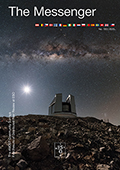
The March 2023 issue of the Messenger (190) is a special edition, dedicated to the 4MOST Community Surveys. This complements the presentation of the 4MOST consortium's ten survey proposals in issue 175 of The Messenger.
In the issue, available here, each of the 15 Community Surveys is presented in a three-page article. A necessary reading for everyone interested in 4MOST!
Introducing the new leader of the Communication and Education WG
2023-06-12
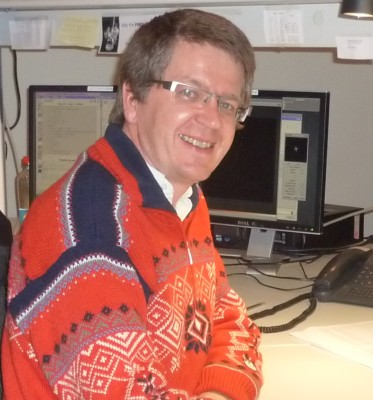
The 4MOST Principal Investigator, Roelof de Jong, is very pleased to announce Henri Boffin as our new lead for the Communication and Education Working Group (formerly called Outreach WG). Henri is a Full Astronomer at ESO, working on binary stars, exoplanets, and clusters. Within the 4MOST Project, he is a member of the Survey 4SYS (S12).
Next to having a PhD in astronomy, Henri has a formal training as journalist from the École supérieure de journalisme de Lille, France. He joined ESO in 2003 as Astronomer and Press Officer, dealing with communication about all telescopes and projects of ESO, and became the Deputy Head of the ESO Public Affairs Department. There he dealt with all aspects of communication: writing press releases; communicating with journalists, the public, and politicians; being the technical editor of the Messenger; taking care of the web site; and producing press kits, exhibitions, and education material.
Henri is looking forward to working with all 4MOST members and the institutional Communication groups to develop an encompassing science communication strategy for the Project with the aim to develop the internal newsletter, develop the web site for astronomers, journalists, and the public, and its associated blog, write press releases and interact with journalists, develop educational material, and ensure a social media presence, among others.
Executing such an ambitious programme requires a large team and we are in the process of creating a new Science Communication and Education WG. We expect to issue a call for membership of this new WG in the next few weeks for all those 4MOST members with a keen interest in the area of science communication and education. Please consider joining Henri in this important effort.
Seeking 4MOST Ombudspersons
2023-06-09
A message from the Principal Investigator, Roelof de Jong:
As part of its commitment to diversity and inclusion, the 4MOST Project has appointed Ombudspersons to help 4MOST members who experience problems or conflicts within the Project environment. More specifically, our Code of Conduct obliges us to have at least two Ombudspersons from different institutes at any time. As one of our current Ombudspersons will leave their position and we want to increase the number of Ombudspersons from two to three, we hereby invite nominations to fill these two open positions.
Role description:
Ombudspersons are officially appointed persons who provide
independent, confidential, and neutral advice to 4MOST members in case
of problems and conflicts within the Project. They should also be able
to provide current information about services, programs, policies, and
procedures. They will try to resolve problems through mediation or by
making recommendations to the 4MOST leadership. Ombudsperson
appointments are for 3 years initially, indefinitely renewable. When
wanted or needed, the 4MOST Ombudspersons may receive special training
for this important and responsible job. Information about the
Ombudspersons can be found in the right-hand column of every page on
our website, and in this more detailed
description.
Qualifications:
- Commitment to Diversity, Equity and Inclusion;
- Familiarity with the functioning of the Project and its organisational structure;
- No major leadership or supervisory role within 4MOST that may compromise impartiality.
Nomination and selection process:
We invite nominations (with consent from the candidate) or
self-nominations from all 4MOST members. In case of self-nomination,
we will request a letter of support from one or more persons well
familiar with the candidate. A selection committee consisting of the
current Ombudspersons, the Project Scientists, and the 4MOST PI, will
review the nominations and make recommendations that are subject to
final approval by the 4MOST Executive Board.
Nominations shall be sent to the 4MOST PI with the following contents:
- Nominee's name.
- Nominee's email.
- Nominee's institutional affiliation.
- Career stage that best describes the nominee for the next two years (e.g., graduate student; postdoctoral researcher; research staff scientists / engineer; junior / senior / emeritus professor).
- Roles (if any) of the nominee in the Project.
- Nominee's 4MOST-related interests (up to one paragraph).
- Nominee's experience with the Ombudsperson's related activities, if any.
- In case of a self-nomination, contact details of one or more persons who may be contacted for a letter of reference.
All nominations received by 30 June 2023 will receive full consideration.
We are looking forward to receiving nominations for a diverse set of Ombudsperson candidates.
Introducing the new extragalactic deputy Project Scientist
2023-01-18
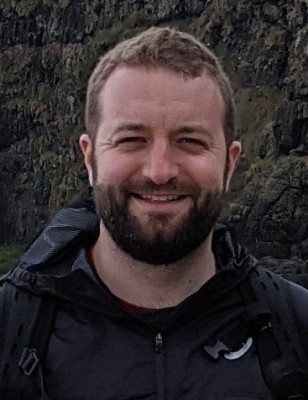
The 4MOST Project Scientists, Karin Lind and Jon Loveday, are pleased to announce that Chris Frohmaier has been selected to be the new extragalactic deputy Project Scientist. Chris works in the field of Time-Domain Astronomy, specialising in the astrophysics of supernovae, their host galaxies, and their applications in cosmology. His career has been spent working on data from large all-sky surveys such as the Palomar Transient Factory and the Dark Energy Survey. He has made precise measurements of intrinsic transient rates and written software to simulate sky surveys. His software has been used to measure properties for populations of transients from the most common supernovae to the single discovery of a kilonova. Chris' research also focuses on the real-time discovery of unusual transient events, with a particular interest in faint-and-fast thermonuclear explosions.
Chris has previously worked as a Data Intensive Science Research Fellow and is now an LSST:UK Senior Research Fellow and software engineer. 4MOST is primed as the best spectroscopic facility to follow LSST transient discoveries and create a revolutionary dataset for the community. Chris is keen to bring his time-domain experience to the extragalactic deputy Project Scientist role and is looking forward to contributing to an inclusive and dynamic research environment.
The Project Scientists and the Principal Investigator, Roelof de Jong, would also like to take this opportunity to thank Luke Davies for his excellent work as the previous Extragalactic deputy Project Scientist.
Introducing the new Chair of the Science Coordination Board
2023-01-17
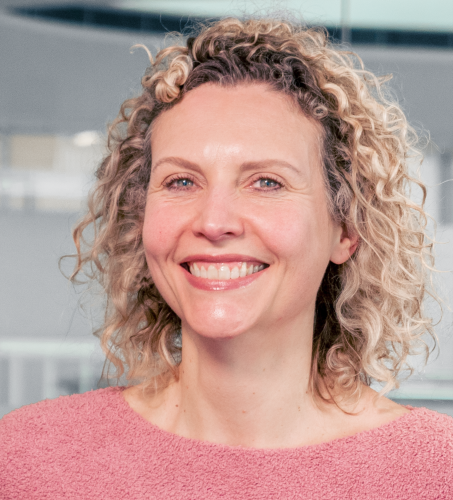
A message from the Principal Investigator, Roelof de Jong:
I am pleased to announce that at its last meeting, the 4MOST Science Coordination Board (SCB) selected Michelle Cluver (co-PI of S18) as its new Chair, after Joe Liske stepped down having chaired for eight years. The 4MOST Executive Board has now formally appointed Michelle as new Chair of the SCB.
Michelle has been involved in the planning and execution of large spectroscopic surveys since joining the Australian Astronomical Observatory and the GAMA (Galaxy And Mass Assembly) Survey in 2011. Her expertise is in infrared photometry and spectroscopy, pioneering the use of WISE as a tracer of stellar mass and star formation in combination with large redshift surveys. Her scientific interest lies in the evolution of galaxies within groups, a key environment in the transformation of galaxies from star-forming disks to bulge-dominated, relatively quiescent systems. Since the distribution of neutral gas, the fuel that drives star formation, is a singular tracer of past interactions, she co-leads the MeerKAT Habitat of Galaxies Survey (MeerHoGS) exploring (among other things) how the SKA and its Pathfinders will probe the cold intra-group medium and how this relates to accretion and shocks. Aside from enabling the unprecedented study of environment in combination with multi-wavelength tracers, Michelle is most excited about how 4MOST will uncover unexplored large-scale structures, including pushing deeper into the Zone of Avoidance compared to traditional extragalactic surveys (an interest sparked during her PhD and central to our understanding of mass and motion in the local universe). The 4MOST project is a pioneering survey model and Michelle feels privileged to lead the SCB as we navigate the challenges and opportunities in preparation for full survey operations.
The entire SCB and especially me personally would like to thank the outgoing Chair, Joe Liske, who will continue as the deputy Chair during the transition period. Joe has been instrumental for setting up the organisational structure and regulations of the science section of the 4MOST Project and for creating the path to a collaborative environment that enables the 4MOST operational model. Next to being deputy SCB Chair while Michelle gets up to speed, Joe will also remain lead of the Administration & Communication Tools Work Package.
